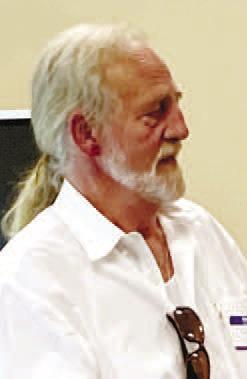MORGAN COUNTY
The Morgan County Landmarks Society hosted a look at 200 years of changing landscapes and architecture Sept. 18, with guest speakers Joe Smith, a preservation architect, and preservation builder Curtis Whitsel.
Smith spoke on the history of Morgan County, the history and rehabilitation of the Foster-Thomason-Miller house, and the history and rehabilitation of the local train depot, while Whitsel described how to assess if a house can be moved to another location and if so, how to safely do so.
Smith explained that Morgan County was officially separated from Baldwin County in 1807 on what originally was forested Creek land.
During the 19th century, he said, the county had one of the highest enslaved populations in Georgia— above 70 percent—as the land was cleared for agriculture and cotton became a key industry.
However, when the boll weevil infestation began in 1916 it decimated crops and would take more than 15 years for cotton production to recover. Other crops like peaches and pecans were grown during this time and pine trees were planted on the vacant terraced cotton fields, Smith said.
Throughout the 1920s, he added, Morgan County’s population decreased from about 20,000 to 12,000 and to date has never again exceeded the 1920 population.
Smith then shared the origins of the Foster-Thomason-Miller house, built in 1883 by contractor Daniel Towns on the site of the former Georgia Female College for Legare Hill Foster. Debt and a defaulted loan forced the house to be sold in 1887 to Robert Usher Thomason, who made various changes to the structure, including covering interior stencil work and adding electricity in 1920.
Once again changing hands in the 1970s, the house was fully restored and by 1986 had received a 1986 Georgia Trust Preservation Award. But after sustaining extensive damage from a 2001 fire, the house remained vacant for many years until purchased and stabilized by the Madison-Morgan Conservancy. In 2019, the property was sold to its present owners, Elizabeth and David Minnix, who are currently restoring the structure as closely as possible to the original, including the slate roof.
Smith said the Central of Georgia train depot tells the story of the commercial and social history of Madison. Additionally, the depot provided communication services through telegraph and telephone exchanges.
An older train depot once existed, he said, but was replaced in 1901 after residents demanded a train station with segregated waiting rooms and toilets. By the late 1950s, though, passenger rail in Georgia slowly came to an end and the depot then sat unused for many years.
In exploring the site, Smith said he discovered more about the structure’s history and found names of businesses that shipped from the depot between 1906-1908 written in black paint on the freight room walls.
Whitsel recently helped relocate the structure a short distance to its current location where a pole porch was added back to the depot and a new shingle roof installed.
Whitsel used the Kimble-Crawley-Davis House as a specific example for his portion of the presentation, as he and his crew had recently relocated it from the original site off Old Post Road in Rutledge to Madison’s historic district.
The house is comprised of an early 1800s cabin that was connected in the early 1900s to the back of a circa-1829, two-story I-house.
Portions of the house needed to be dismantled to accommodate a maximum height of 17 feet in order to clear power lines along the roads, Whitsel explained, and the second floor had to be lifted off and moved as a section. He noted that reconstructing the house will be equally challenging and the process will require several months to make the structure livable. The next meeting for the Morgan County Landmarks Society will be on Oct. 16, at the Morgan County Library. Guest speaker Terry Tatum, archivist at the Morgan County Archives, will present “How Morgan Moved: Transportation Over the Years.”
Presentations are free for the public to attend. For information on membership, email mclandmarks@ gmail.com.

